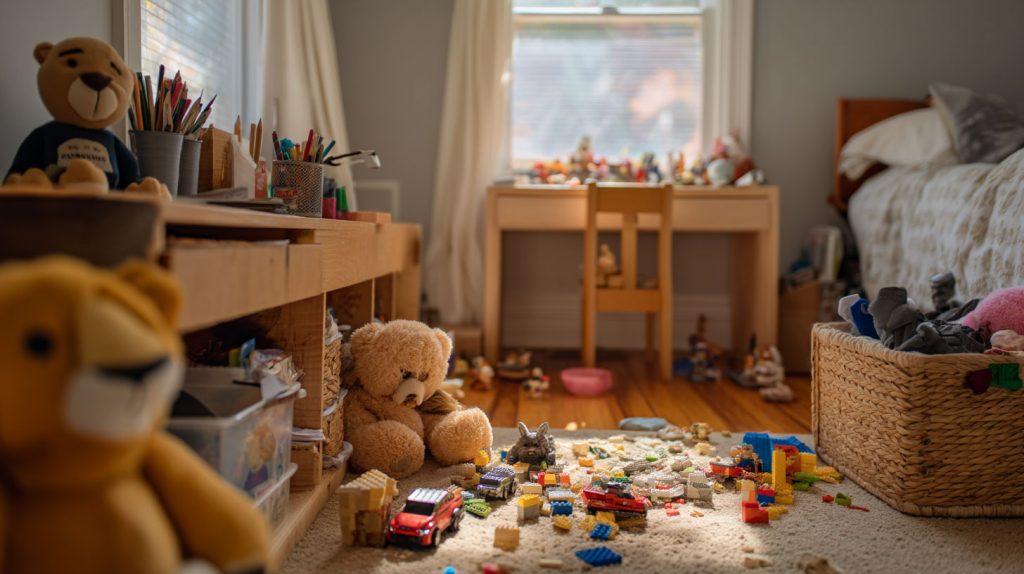
No room in a family home exposes reality faster than a kids’ bedroom.
You can hide dishes in the dishwasher, laundry behind a closet door, and hallway chaos in a decorative basket.
But a child’s room? It tells the truth, the whole truth, and nothing but the truth.
Toys, blocks, crafts, random puzzle pieces, a single shoe, three pens with no caps, a rock collection, a dinosaur missing its tail — and somehow, a toothpaste stain. No witnesses, no explanation.
The Toy Explosion Theory (TOT), simplified
It works like this:
- One toy is taken out — everything is fine
- A second toy joins — still safe
- Somehow, 17 toys appear out of nowhere
- Within minutes, the room looks like a toy-themed natural disaster
The science behind it?
Kids don’t play in lines. They play in spreads.
Adults unpack one thing at a time.
Kids unpack entire worlds.
Why cleaning a child’s room is psychologically different
When adults tidy a space, we:
- Finish one zone before moving to the next
- See progress as motivation
- Clean with intention
Kids, however:
- Operate in parallel play universes
- Switch activities before closure
- Don’t see mess, they see possibility
To a kid, a clean floor is not impressive.
It’s unused play potential.
The hidden mess multipliers parents rarely notice
It’s not just toys creating chaos. It’s the ecosystems around them:
1. Micro-pieces
Lego bricks, LOL accessories, puzzle edges, dinky puzzle confetti that breeds at night.
2. Theme migration
Toys don’t stay grouped.
Barbies attend dinosaur meetings. Toy cars go grocery shopping in the dollhouse.
3. The project table phenomenon
One craft project becomes 12 unfinished art installations.
4. The emotional difficulty of throwing anything away
Because:
- “I still play with it!”
- “I need it for something!”
- “It’s my favorite!” (hasn’t been touched since 2023)
The truth nobody says out loud
Parents usually give up cleaning kids’ rooms not because it’s hard…
But because they know it won’t stay clean long enough to emotionally justify the effort.
So cleaning becomes:
- A negotiation
- A scavenger hunt
- A diplomatic mission
- Sometimes a mild crisis response
But not a simple process.
Why common solutions fail
| Tried solution | Why it fails |
|---|---|
| “Pick one toy at a time” | Kids don’t play one toy at a time |
| “Put everything back where you found it” | Nothing has a permanent homeland |
| “Let’s clean it together right now” | Usually happens during peak chaos hours |
| “Less toys = less mess” | Wrong. Same mess, fewer options, same spread |
| “Just use storage bins” | Turns into invisible toy landfill |
The missing piece isn’t discipline — it’s infrastructure
Kids don’t need better rules.
They need a room system built for non-linear play.
The 5-Zone Room Setup (Life-Changing, Not Pinterest)
Forget sorting toys by color, brand, or spiritual alignment.
Use play-based zones instead:
- Build Zone → Lego, blocks, magnetic tiles
- Imagine Zone → dolls, costumes, plush, pretend sets
- Move Zone → floor space for cars, tracks, animals, floor games
- Create Zone → crafts, markers, paper, stickers
- Reset Zone → the magic bin for fast clean-ups
This works because children think in activities, not categories.
The Reset Bin: The best invention since silence
This is a large open bin or basket with one purpose:
“If you don’t know where it goes, it goes HERE.”
No guilt. No sorting. No breakdowns.
The Reset Bin gets emptied later, not during the cleanup moment.
This alone removes 70% of cleaning resistance.
The 6-Minute Room Reset (That Kids Will Actually Do)
Set a timer and run this sequence:
- Big items first (stuffies, blankets, costumes)
- Floor sweep (anything you can grab without thinking)
- Tiny items into the Reset Bin (no sorting!)
- Obvious trash out
- Surfaces cleared (desk, nightstand, shelves)
- One final floor check
Done. No perfectionism. No spiraling.
The secret: speed beats accuracy.
The “Visible & Reachable” Law of Kids’ Organization
If a kid can’t:
- see it
- reach it
- open it
- understand it
- shut it again
…it will not be used correctly. Ever.
So the rule becomes:
- No lids that require obedience
- No bins they can’t reach
- No storage they have to decode
- No adult-sized logic systems
Transparency and accessibility win every time.
Small pieces no longer live free
Tiny toy pieces follow one rule now:
They live in clear containers with one label kids understand:
- Lego
- Tiny animals
- LOL stuff
- Dino accessories
- Car road pieces
Not “miscellaneous,” not “parts,” not “important bits.”
If kids can’t describe it — they can’t store it.
Rotation beats reduction
Throwing toys away creates emotional damage.
Hiding some of them creates relief.
Use the toy rotation method:
- 50% available
- 50% resting
- Swap every 2–3 weeks
Less mess, same magic.
The psychological trick that ends negotiations
Never say:
“Go clean your room.”
Say:
“Run the 6-minute reset.”
One feels endless.
The other feels like a tiny mission they can win.
Kids don’t hate cleaning.
They hate infinite tasks with invisible finish lines.
What a successful kids’ room actually looks like
- The floor is mostly visible
- The setup survives 24 hours
- Toys return without therapy sessions
- You can walk without emotional damage
- Cleaning is fast enough to happen regularly
Not spotless.
Just functional.
And that’s the real victory.


